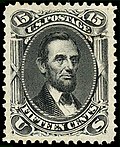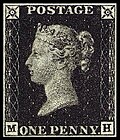Postage stamp

Postage stamps are pieces of paper which signal that payment has been made for the item to be mailed.
These days they have adhesive on the back. They are put on the top right-hand corner of an envelope. They pay the fee for having the postal service take the envelope to where it is being sent.
The idea was British, and the first postage stamps were issued in Britain in the mid-nineteenth century. On 1 May 1840, the Penny Black, the first adhesive postage stamp, was issued in the United Kingdom.
There are a lot of different postage stamps in the world. Most countries have their own stamps. People collect them in books called stamp albums. Sometimes, the stamps all have errors in the printing like in the "Inverted Jenny" picture with the aeroplane printed upside down.
People on stamps
People on stamps is one more common topic in stamp collecting. For instance, many famous people are featured on stamps in the United States.
- Examples of people on U.S. stamps
Maps on stamps
Maps on stamps is a common topic on stamp collecting. Almost every country has featured maps on stamps. There are also topic maps including demographic and cross topic ones (showing explorer routes over maps).
- Examples of maps on stamps
Coat of Arms "Bayern" and Germany map
"Eire", 1922 Ireland
Postage Stamp Media
The Penny Black, the world's first postage stamp (1 May 1840)
The US Mail postage stamp of Marshal C. G. E. Mannerheim from 1961
The Penny Red, 1854 issue, the first officially perforated postage stamp
The first officially perforated United States stamp (1857)
The 1985 postage stamp for the 115th birth anniversary of Vladimir Lenin. Portrait of Lenin (based on a 1900 photography of Y. Mebius in Moscow) with the Tampere Lenin Museum.
A Costa Rica Airmail stamp of 1937
Related pages
Other websites
| Wikimedia Commons has media related to Lua error in Module:Commons_link at line 62: attempt to index field 'wikibase' (a nil value).. |
 The dictionary definition of postage stamp at Wiktionary
The dictionary definition of postage stamp at Wiktionary















